Explore Aranyaprathet - Thailand Travel, Asia
Nestled near the Cambodia border, Aranyaprathet is more than just a transit point on your way to Siem Reap and the Angkor Wat temples. This charming town in Sa Kaeo Province is steeped in history, brimming with cultural influences, and offers an authentic slice of Thai life that is often overlooked by travelers. With a blend of Thai and Khmer cultures, Aranyaprathet invites you to explore its rich heritage, interact with its welcoming locals, and uncover the hidden gems that make this destination special.
Population: Approximately 86,000 in 2014.
Economy: Aranyaprathet's economy thrives on trade, agriculture, and tourism. Its strategic location near the Cambodian border boosts cross-border commerce and local markets, supporting diverse economic activities.
Landmarks: Famous for the Wat Anu Banphot, Sa Kaeo Salt Flats, and Rong Kluea Market.
Thailand
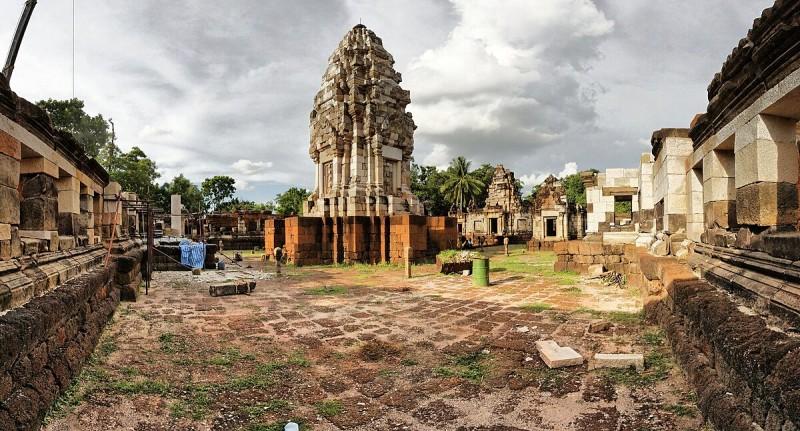
Overview of Aranyaprathet
History & Cultural Influence
Aranyaprathet’s history is deeply intertwined with its proximity to Cambodia. Historically, it has served as a crucial gateway for trade and cultural exchange between the two nations. The town’s past is reflected in its architecture, language, and traditions, which carry both Thai and Khmer influences. Together with key historical events that have left an indelible mark on the town, many of the local temples and monuments bear testimony to this shared history. Furthermore, the cultural influence extends beyond architecture to the everyday lives of the people.
Interaction with the Locals
Aranyaprathet is a small yet vibrant town with a population of approximately 86,000 people. The citizens here are predominantly Thai, with a significant influence from Khmer culture due to the town's proximity to the Cambodia border. The locals are known for their warm hospitality and strong sense of community, often blending traditional Thai and Khmer customs in their daily lives. This cultural mix is reflected in the town’s language, food, and festivals, making Aranyaprathet a unique and culturally rich destination.
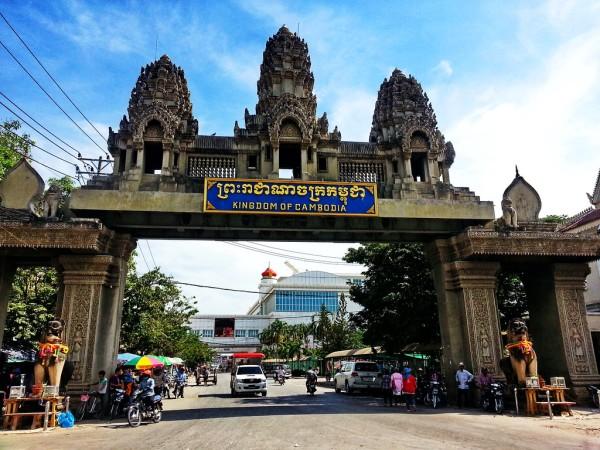
Aranyaprathet, close neighbor of Cambodia - © Flickr
Top Attractions in Aranyaprathet
Wat Anu Banphot
Wat Anu Banphot is the spiritual heart of Aranyaprathet, offering a serene escape into the town's religious heritage. The temple is renowned for its stunning architecture, which blends traditional Thai and Khmer styles. As you walk through its grounds, you’ll notice intricate carvings that depict scenes from Buddhist mythology, each telling a story of faith and devotion. The temple's serene environment makes it perfect for silent reflection. Don’t miss the opportunity to witness a traditional prayer ceremony, where the rhythmic chanting of monks fills the air, creating a deeply spiritual experience.
Sa Kaeo Salt Flats
The Sa Kaeo Salt Flats are a natural wonder and a vital part of the local economy. These huge flats extend out under the great sky, resulting in a bizarre and stunning scenery. During the salt-harvesting season, the flats are a hive of activity as workers rake the gleaming crystals into mounds, a practice that has been passed down through generations. Visiting the salt flats offers a unique glimpse into this traditional industry. The best time to visit is during the late afternoon when the setting sun casts a golden hue over the salt crystals, making it a photographer’s dream.
Rong Kluea Market
Rong Kluea Market is one of the largest and most vibrant border markets in Thailand, attracting visitors from both sides of the Thai-Cambodian border. The market is a bustling hub of commerce, where you can find everything from locally made handicrafts to imported goods at bargain prices. Thai silk, traditional clothing, and handmade jewelry are among the popular items for sale. The market is also known for its selection of antiques and curios, perfect for those looking for unique souvenirs. Bargaining is expected here, so be sure to hone your negotiation skills for the best deals.
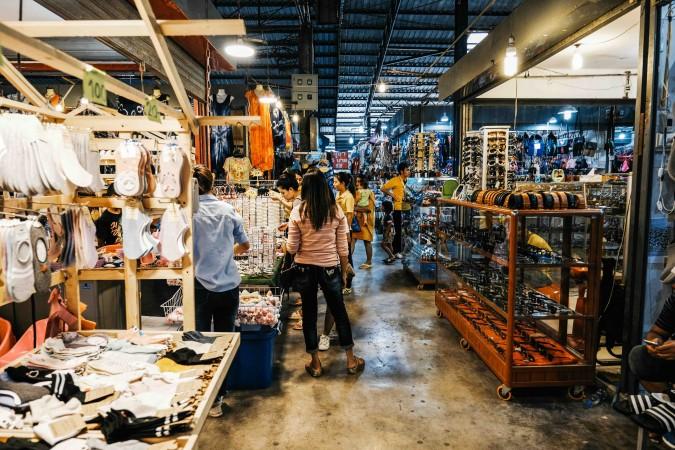
Rong Kluea Market - © Thailand Tourism
Must-Try Dishes in Aranyaprathet
This selection of dishes offers a taste of the unique culinary fusion that defines Aranyaprathet, making your dining experience in the town truly memorable.
- Som Tum (Papaya Salad): A staple of Thai cuisine, Som Tum is a spicy papaya salad that’s popular across Aranyaprathet. Made with shredded green papaya, chilies, lime juice, and fish sauce, it’s a refreshing dish with a kick of spice.
- Amok Trey: Amok Trei is a Khmer dish that has found its way into the local palate. This dish features fish steamed in banana leaves with a rich coconut milk and herb sauce. It’s fragrant, creamy, and a must-try for seafood lovers.
- Kuay Teow (Rice Noodle Soup): Kuay Teow is a comforting rice noodle soup served with your choice of pork, beef, or chicken. The broth is light but tasty, and it is frequently cooked with fragrant spices. It’s a simple, satisfying dish enjoyed by locals at any time of day.
- Sai Krok Isan (Isan Sausage): Sai Krok Isan is a fermented sausage that’s both tangy and savory, typically served with fresh vegetables and sticky rice. It’s a popular snack in Aranyaprathet, reflecting the influence of the Isan region in the town's cuisine.
- Lok Lak: Lok Lak is a stir-fried beef dish with roots in Cambodian cuisine. The beef is marinated in a flavorful mix of soy sauce and garlic, then served with rice and a zesty lime-pepper dipping sauce. It’s a hearty, satisfying dish that’s perfect for a quick meal.
- Yam Pla Duk Foo (Crispy Catfish Salad): Yam Pla Duk Foo is a crispy catfish salad that’s both light and flavorful. The catfish is fried until golden and served with a tangy green mango salad, creating a delightful contrast of textures and tastes.
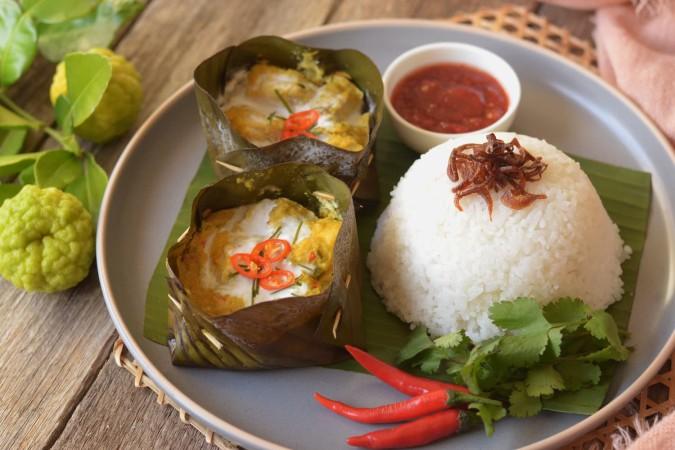
Amok Trey - © Asian Inspirations
Festivals & Local Celebrations
Aranyaprathet is home to a variety of vibrant festivals and celebrations that offer a deep dive into the local culture. These events are not only a time of joy and festivity but also provide insight into the town’s traditions and communal spirit.
Songkran Festival (Thai New Year)
Celebrated in mid-April, Songkran is Thailand’s New Year festival and one of the most anticipated events in Aranyaprathet. The festival is known for its water fights, where locals and visitors alike take to the streets with buckets, water guns, and hoses to drench each other in good fun. Beyond the playful water battles, Songkran in Aranyaprathet also involves traditional activities such as visiting temples, offering food to monks, and pouring water over Buddha statues as a symbol of purification and renewal.
Pchum Ben (Ancestor’s Day)
Reflecting the Khmer influence, Pchum Ben is a significant religious festival in Aranyaprathet, observed by the local Cambodian community. Held in September, this festival is dedicated to honoring the spirits of the deceased. Families gather at temples to make offerings of food and flowers to their ancestors. The festival is marked by solemnity and reverence, but it’s also a time of togetherness and community, where stories and memories are shared among loved ones.
Loy Krathong
Loy Krathong is one of Thailand’s most beautiful festivals, celebrated on the full moon of the 12th lunar month, usually in November. In Aranyaprathet, locals gather by rivers, ponds, and lakes to release krathongs—small floats made of banana leaves, flowers, and candles—into the water. This act symbolizes the release of negative feelings and the wish for good fortune in the coming year. The sight of hundreds of flickering candles floating on the water is truly mesmerizing and offers a magical experience for visitors.
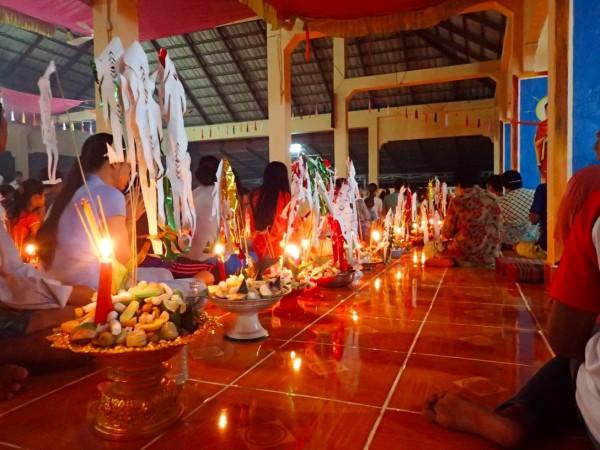
Pchum Ben (Ancestor’s Day) - © Thailand Tourism
What to Do in Aranyaprathet
Explore a variety of activities in Aranyaprathet that cater to different interests. These activities offer a blend of adventure, culture, and relaxation, making your visit to Aranyaprathet both enriching and enjoyable.
- Cycling Tours in Aranyaprathet: One of the best ways to explore Aranyaprathet and its surroundings is by bike. Cycling tours are popular here, allowing you to discover the scenic countryside, visit local farms, and interact with villagers. The flat terrain and quiet roads make it an enjoyable experience for cyclists of all levels.
- Temple Visits: For those interested in spirituality and history, visiting the temples in and around Aranyaprathet is a must. Temples like Wat Anu Banphot offer a peaceful retreat where you can learn about Buddhist practices, observe local rituals, and appreciate the intricate architecture.
- Local Markets Exploration: Rong Kluea Market is particularly famous for its wide range of goods, from fresh produce to clothing and electronics. The market’s vibrant atmosphere, filled with the sounds of bargaining and the smells of street food, offers a sensory experience that’s both exciting and authentic.
Shopping in Aranyaprathet
Shopping in Aranyaprathet is a delightful experience, offering a mix of traditional markets and modern shopping venues.
- Rong Kluea Market: As the largest market in the area, Rong Kluea is a shopper’s paradise. The market spans several acres and is divided into different sections, each specializing in various types of products. From Thai silk and handcrafted jewelry to second-hand clothing and electronics, the variety of items is impressive.
- Aranyaprathet Night Market: Open every evening, the market is a great place to shop for local snacks, handmade crafts, and affordable clothing. The stalls are set up under the open sky, creating a casual and friendly environment. It’s also an excellent spot to sample street food, with vendors offering everything from grilled meats to sweet desserts.
- Local Handicraft Shops: In addition to the markets, Aranyaprathet has several small shops that specialize in local handicrafts. These shops offer a more curated selection of items, including traditional textiles, pottery, and wood carvings.
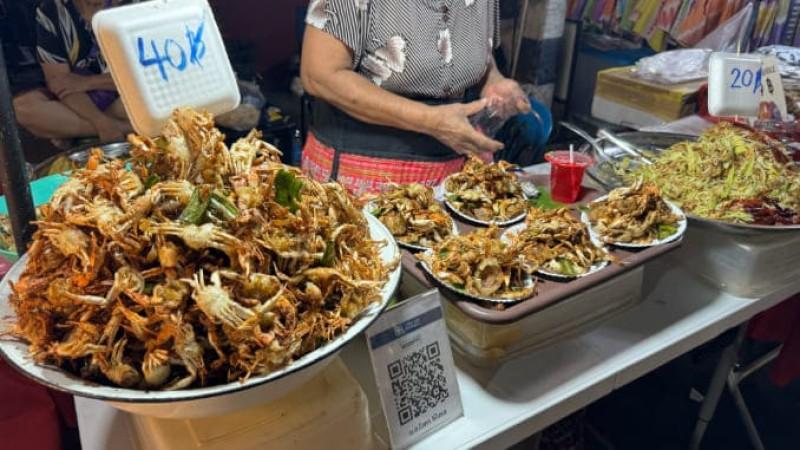
Sampling street foods at Aranyaprathet Night Market - © Paste Magazine
Weather in Aranyaprathet: Best Time to Visit
Hot Season in Aranyaprathet
Temperatures during this period can reach up to 40°C (104°F), making it the least crowded time to visit. The intense heat keeps many tourists away, but this season is perfect for those seeking quieter attractions and lower accommodation rates. Early mornings and late afternoons are the best times for sightseeing, with indoor activities or poolside relaxation recommended during the hottest hours.
Rainy Season in Aranyaprathet
The monsoon brings frequent showers and lush landscapes. While the rains can be heavy, they usually come in short bursts, leaving ample time for exploration. This season sees a moderate number of tourists, particularly nature lovers who appreciate the verdant scenery. It's also a great time for budget travelers, as many hotels offer discounts. Simply prepare your rain gear and flexible travel plans.
Cool Season in Aranyaprathet
This is the peak tourist season in Aranyaprathet, thanks to the mild and pleasant weather, with temperatures ranging from 20°C to 30°C (68°F to 86°F). The cool, dry conditions make it ideal for outdoor activities and sightseeing. Expect more crowded attractions and higher prices, especially during the holiday period. Early bookings are recommended if you plan to visit during this popular time.
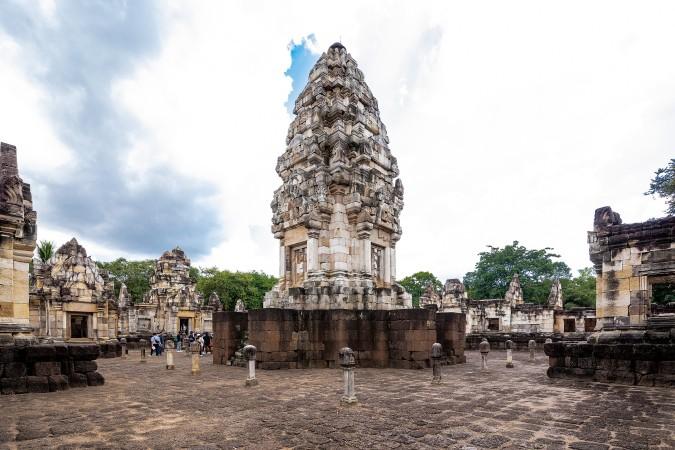
Spend a morning to visit Prasat Sdok Kok Thom near Aranyaprathet - © Wikimedia
Essential Travel Information
Getting Around Aranyaprathet
- Tuk-Tuks: Tuk-tuks are a common mode of transport and are ideal for short distances around town. They’re affordable, and the drivers are usually knowledgeable about local attractions.
- Motorbike Taxis: For quicker and more flexible transport, motorbike taxis are a popular choice. They’re great for navigating through traffic and reaching destinations faster, but always wear a helmet for safety.
- Songthaews: These shared pickup trucks with benches in the back are a cost-effective way to travel longer distances within the town or to nearby areas. They follow set routes, making them a convenient option for budget travelers.
- Car Rentals: For those who desire greater independence, hiring a car is an alternative. It’s particularly useful if you plan to explore areas outside of Aranyaprathet. Ensure you have an international driving permit and are comfortable driving in Thailand.
ATM & Banking Services
Aranyaprathet provides simple ATM and banking services to meet your financial needs. ATMs are readily available throughout the town, especially near major attractions and the border area, allowing for easy access to cash with international cards. For additional banking services such as currency exchange, international wire transfers, and account management, you can visit local bank branches. These are normally open during regular business hours and may require your passport for transactions. Credit cards are accepted at larger hotels, restaurants, and shops, but it's wise to carry some cash for smaller vendors and local markets where card payments might not be available.
Where to Stay in Aranyaprathet
- Budget Guesthouses: For travelers on a budget, there are several guesthouses and hostels that offer basic amenities at affordable prices. Popular options include simple rooms with fans or air conditioning, free Wi-Fi, and convenient locations near the town center.
- Mid-Range Hotels: If you’re looking for more comfort, mid-range hotels in Aranyaprathet offer amenities such as air-conditioned rooms, on-site restaurants, and swimming pools. These hotels often provide a good balance between comfort and cost, making them a popular choice for both solo travelers and families.
- Luxury Resorts: For a more luxurious stay, there are a few high-end resorts in the area, offering premium services and facilities. These resorts often feature spacious rooms, wellness centers, fine dining, and beautifully landscaped grounds.
- Boutique Hotels: Aranyaprathet also has a selection of boutique hotels that offer unique, stylish accommodations with personalized service. These hotels frequently include local art and design, ensuring a culturally rich experience. They’re perfect for travelers looking for something different and intimate.
- Homestays: These accommodations allow you to live with a local family, offering a unique perspective on daily life in Aranyaprathet. Homestays typically include meals and provide an opportunity to engage with local culture and customs directly.
Articles for you

Explore Yala National Park - Sri Lanka Travel, Asia
Tucked away in Sri Lanka’s southeastern corner, Yala National Park is where wild nature meets deep tradition. Known worldwide for its leopard population, the park is also home to elephants, sloth bears, crocodiles, and hundreds of bird species. Beyond wildlife, Yala opens doors to a cultural landscape dotted with ancient temples, Buddhist ruins, and coastal villages. For travelers seeking more than just a safari, Yala offers a chance to explore eco-tourism, local communities, and sacred heritage sites.
Population: The Yala National Park area doesn’t have a human population.
Economy: The economy around Yala National Park thrives on a blend of eco-tourism, agriculture, and local services. Safari tours, eco-lodges, and cultural experiences drive steady income for nearby towns like Tissamaharama and Kataragama, supporting thousands of families.
Landmarks: Famous for Block I of Yala and wildlife encounters, including elephants, sloth bears, crocodiles, and exotic bird species.

Explore Galle - Sri Lanka Travel, Asia
Nestled on Sri Lanka’s southern coastline, Galle is a vibrant city where history meets the sea. Its cobbled streets, colonial architecture, and serene beaches make it a must-visit destination for travelers seeking a blend of culture, adventure, and relaxation. A UNESCO World Heritage site, Galle captivates visitors with its Dutch Fort, bustling markets, and friendly locals. Whether you’re exploring the ramparts at sunset or savoring fresh seafood by the shore, Galle promises an unforgettable journey into Sri Lanka’s heritage.
Population: Approximately 113,000 in 2023.
Economy: Galle’s economy thrives on tourism, trade, and fisheries. The city’s historic fort, colonial architecture, and coastal charm draw thousands of international visitors each year, making tourism its main economic driver. Fishing remains vital for local livelihoods, supplying fresh seafood across the region.
Landmarks: Famous for the Galle Fort, Dutch Reformed Church & Maritime Museum, and Unawatuna Beach.

Explore Bentota - Sri Lanka Travel, Asia
Nestled along Sri Lanka’s southwestern coast, Bentota is a tropical paradise that blends golden beaches, vibrant culture, and thrilling adventures. Famous for its calm waters, luxury resorts, and scenic river estuary, Bentota has become a top destination for travelers seeking both relaxation and authentic experiences. From serene beach walks at sunrise to adrenaline-pumping water sports, this coastal town offers a perfect balance of leisure and exploration. With its proximity to Colombo and Galle, Bentota is easy to reach, making it an ideal stop for both short escapes and extended holidays.
Population: Approximately 37,000 in 2023.
Economy: Bentota’s economy thrives mainly on tourism, which drives local businesses such as hotels, restaurants, and wellness retreats. The town also benefits from fishing, coconut cultivation, and handicrafts like wood carving and batik textiles. Many residents rely on the growing demand for water sports and Ayurvedic treatments, making tourism the backbone of both income and employment in the area.
Landmarks: Famous for Bentota Beach, Bentota River Safari, and Kande Vihara Temple.

Explore Mirissa - Sri Lanka Travel, Asia
Mirissa is a charming coastal town on Sri Lanka’s southern shoreline. Known for its golden beaches, turquoise waters, and vibrant marine life, it has become a must-visit stop for travelers exploring the island. Many come for whale watching, surfing, and sunset views at Coconut Tree Hill, but Mirissa offers much more than postcard beauty. The fishing boats you see anchored by the bay carry generations of stories. Local traditions, delicious cuisine, and a laid-back rhythm of life shape every visitor’s experience.
Population: Approximately 4,700 in 2023.
Economy: Mirissa’s economy is largely shaped by its coastal location. Fishing has long been the backbone of local livelihoods, with generations relying on the Indian Ocean for income. In recent decades, tourism has become the main driver of growth, thanks to whale watching, surfing, and beachside hospitality.
Landmarks: Famous for Mirissa Beach, Coconut Tree Hill, and Parrot Rock Bridge.

Explore Nuwara Eliya - Sri Lanka Travel, Asia
Tucked away in the Central Highlands of Sri Lanka, Nuwara Eliya is often called “Little England”. With its rolling tea plantations, cool misty mornings, and colonial charm, this mountain town feels like a step into another world. Travelers come here to breathe fresh air, walk through flower gardens, sip the finest Ceylon Tea, and enjoy a pace of life far from the island’s busy cities. Whether you’re drawn by scenic landscapes, heritage architecture, or the warmth of its people, Nuwara Eliya is a destination that blends nature, culture, and history in perfect harmony.
Population: Approximately 781,000 in 2023.
Economy: Nuwara Eliya’s economy thrives mainly on tea production, as it sits in the heart of Sri Lanka’s central highlands, famous worldwide for Ceylon Tea. The city also benefits from a growing tourism industry, attracting visitors with its colonial charm, cool climate, and scenic landscapes.
Landmarks: Famous for Gregory Lake, Hakgala Botanical Garden, and Victoria Park.

Explore Sukau - Malaysia Travel, Asia
Nestled on the banks of the Kinabatangan River in Sabah, Malaysian Borneo, Sukau is a destination where wildlife, culture, and conservation come together. Known as one of Asia’s top spots for river safaris and eco-tourism, this quiet village offers a front-row seat to encounters with Bornean orangutans, pygmy elephants, proboscis monkeys, and exotic birdlife.
Population: Approximately 1,400 in 2019.
Economy: Sukau’s economy is shaped by its riverine location and natural resources. Traditionally, the Orang Sungai community relied on fishing, small-scale farming, and forest gathering for their livelihood. Today, the village has shifted toward eco-tourism, with river cruises, jungle trekking, and homestays providing income.
Landmarks: Famous for the Kinabatangan River cruises, Gomantong Caves, and Ox-bow lakes and wetlands.
